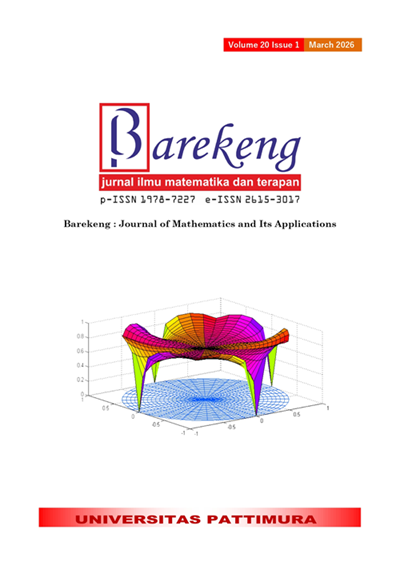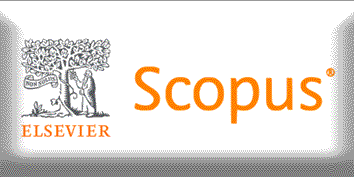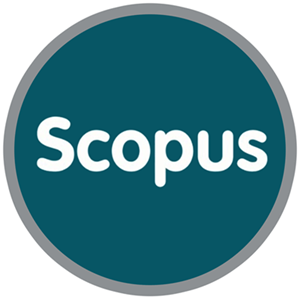COMPANY VALUATION AND PORTFOLIO ANALYSIS BASED ON K-MEANS CLUSTERING IN KOMPAS 100 STOCKS INDEX
Abstract
The capital market plays a vital role in investment, providing a platform for trading long-term financial instruments. Indonesia’s capital market has shown significant growth in recent years. This study aims not only to find stock clusters but to show that grouping stocks based on similar valuation characteristics can serve as a solid foundation for constructing superior-performing portfolios. The Kompas 100 index is used because it represents the most liquid and fundamentally stocks in Indonesia. The k-means clustering method is employed, and the number of clusters is determined using the elbow method. This approach resulted in four clusters, with the cluster identified as containing stocks with low PER, PBV, and PSR, representing the “best” portfolio each year based on valuation. Portfolios were formed from these clusters and compared to benchmark portfolios in Indonesia and globally. Global portfolios used as benchmarks include VSMPX, FXAIX, and SAM Equity. Over five years (2018–2022), the cluster-based portfolios outperformed Indonesian and global benchmarks in 2018, 2021, and 2022, while slightly underperforming global portfolios in 2019 and 2020 but still exceeding Indonesian benchmarks. This confirms that clustering techniques can deliver strong performance compared to conventional methods. A limitation of this study is that it focuses only on return performance without analyzing risk-adjusted returns, which future research should address.
Downloads
References
Kustodian Sentral Efek Indonesia (KSEI), "STATISTIK PASAR MODAL INDONESIA", 2023. https://www.ksei.co.id/files/Statistik_Publik_Desember_2023_v3.pdf. Last accessed March 20, 2025.
Z. Bodie, A. Kane, and A. J. Marcus. INVESTMENTS (11th ed.). New York: McGraw-Hill Education, 2020.
MRA Ardana, WP Setiyono, and S Sriyono. "THE IMPACT OF FUNDAMENTALS AND TECHNICAL ANALYSIS ON STOCK RETURNS IN BANKING COMPANIES LISTED FOR INDONESIA STOCK EXCHANGE 2013-2022". EKOMBIS REVIEW: Jurnal Ilmiah Ekonomi dan Bisnis, 12(2), 2103-2118, 2024. https://doi.org/10.37676/ekombis.v12i2.5505
N. A. Lestari, A. Antony, and A. Alhidayatullah. "EVALUATION OF STOCK THROUGH FUNDAMENTAL ANALYSIS WITH THE DIVIDEND DISCOUNT MODEL (DDM) APPROACH". International Journal of Indonesian Business Review, 2(1), 85-95, 2023. https://doi.org/10.54099/ijibr.v2i1.499
A. Masruroh, K. S. Rachmadanti, T. E. Tania, and M. Y. R. Pandin, "FUNDAMENTAL STOCK ASSESSMENT USING THE DIVIDEND DISCOUNT MODEL AND PRICE EARNING RATIO METHOD FOR INVESTMENT DECISIONS IN THE BANKING SECTOR LISTED ON THE INDONESIAN STOCK EXCHANGE". Jurnal Manajemen Kreatif dan Inovasi, 2(1), 42-52, 2023. https://doi.org/10.59581/jmki-widyakarya.v2i1.2065
M. Skočir and I. Lončarski. "ON THE IMPORTANCE OF ASSET PRICING FACTORS IN THE RELATIVE VALUATION", Research in International Business and Finance, 70, 102366, 2024. https://doi.org/10.1016/j.ribaf.2024.102366
A. Damodaran, THE LITTLE BOOK OF VALUATION: HOW TO VALUE A COMPANY, PICK A STOCK, AND PROFIT. New Jersey: John Wiley & Sons, 2024.
F. Ferdinand, E. Hulu, G. Ugut, and R. Sembel. "VALUATIN OF STOCK VALUE WITH RELATIVE VALUATION AND ABSOLUTE VALUATION APPROACH IN BANKING SECTOR AT LQ 45 PERIOD 2015-2020". Ultima InfoSys : Jurnal Ilmu Sistem Informasi, 15(1), 1-6, 2024. https://doi.org/10.31937/si.v15i1.3410
F. H. Christiansen and M. H. Søderholm. RELATIVE VALUATION: MAN VS. MACHINE CAN AN ALGORITHM BEAT YOUR BROKER?, Thesis, master of Science in Finance and Accounting, Denmark: Copenhagen Business School, 2020.
B. K. Lukanima, "AN OVERVIEW OF RELATIVE VALUATION". In Corporate Valuation A Practical Approach with Case Studies, pp. 613-633, 2023. https://doi.org/10.1007/978-3-031-28267-6_19
T. Deng, Z. Ning, and K. Wan, "CORPORATE VALUE ASSESSMENT BASED ON THE EVA MODEL AND RELATIVE VALUATION", Highlights in Business, Economics and Management, vol. 40, pp. 1177-1183, Sep. 2024. https://doi.org/10.54097/2ttasr58
A. Saputra, R. Yustiana, and R. Hidayat, "ANALISIS PENGARUH PRICE TO SALES RATIO (PSR) DAN PRICE TO BOOK RATIO (PBR) TERHADAP RETURN SAHAM PADA PERUSAHAAN INDUSTRI BARANG KONSUMEN YANG TERDAFTAR DI BURSA EFEK INDONESIA PERIODE 2016-2020", Jurnal Riset Ekonomi dan Manajemen, 8(1), 1-14, 2022. https://doi.org/10.55606/jurnalrisetilmuakuntansi.v1i4.103
T. Issakainen. "CLUSTERING-BASED VALUE INVESTING STRATEGY IN THE HELSINKI STOCK EXCHANGE: K-MEANS ALGORITHM". Journal of Innovation in Business and Economics, 7(2), 115–128, 2023. https://doi.org/10.22219/jibe.v7i02.26424
B. Aslam, RA Bhuiyan, and C. Zhang. "PORTFOLIO CONSTRUCTION WITH K-MEANS CLUSTERING ALGORITHM BASED ON THREE FACTORS". MATEC Web of Conferences: CGCHDRC 2022, 02006, 2023. https://doi.org/10.1051/matecconf/202337702006
H.W. Zhang. "LIMITATIONS AND CRITIQUE OF MODERN PORTFOLIO THEORY: A COMPREHENSIVE LITERATURE REVIEW". Advances in Economics, Management and Political Sciences, 60, 24–29, 2024. https://doi.org/10.54254/2754-1169/60/20231148
S.E. Kemp, M. Ng, T. Hollowood, and J. Hort, DESCRIPTIVE ANALYSIS IN SENSORY EVALUATION, UK: John Wiley & Sons, 2018. https://doi.org/10.1002/9781118991657
N.T. Wulansari, E. Elwisam, and K. Digdowiseiso. "ANALYSIS OF THE INFLUENCE OF PRICE EARNING RATIO, PRICE TO BOOK VALUE, EARNING PER SHARE, DEBT TO EQUITY RATIO AND RETURN ON EQUITY ON SHARE PRICES IN LQ45 COMPANIES ON THE INDONESIA STOCK EXCHANGE 2016-2020". Jurnal Syntax Admiration, 4(2), 332-348, 2023. https://doi.org/10.46799/jsa.v4i2.883
X. Chen, B. Li, and A.C. Worthington. "HIGHER MOMENTS AND US INDUSTRY RETURNS: REALIZED SKEWNESS AND KURTOSIS". Review of Accounting and Finance, 20(1), 1–22, 2020. https://doi.org/10.1108/RAF-06-2020-0171
J. F. Hair, B. J. Babin, R. E. Anderson and W. C. Black, MULTIVARIATE DATA ANALYSIS, 8 ed. Cengage Learning, 2022.
N. H. Spencer, ESSENTIALS OF MULTIVARIATE DATA ANALYSIS (1ST ED.), Florida: CRC Press, 2014. https://doi.org/10.1201/b16344
R. Fajriyah and A. Mahmudiati. KESEHATAN MASYARAKAT INDONESIA 2013: SBRC SERIES ANALISIS DATA KESEHATAN 1.01, Central Java: Eureka Media Aksara, 2023.
C.R. Beidleman, "LIMITATIONS OF PRICE-EARNINGS RATIOS", Financial Analysts Journal, 27(5), 86-91, 1971. https://doi.org/10.2469/faj.v27.n5.86
A. Gunawan, R. Fajriyah, M. Bimakasa, and S. N. Untari, "ANALYSIS OF PORTFOLIO FORMATION ON THE LQ45 STOCKS INDEX, USING THE MARKOWITZ AND SINGLE INDEX MODELS", BAREKENG: J. Math. & App., vol. 18, no. 4, pp. 2363-2374, 2024. https://doi.org/10.30598/barekengvol18iss4pp2363-2374
L. Theron and G. Van Vuuren, "THE MAXIMUM DIVERSIFICATION INVESTMENT STRATEGY: A PORTFOLIO PERFORMANCE COMPARISON", Cogent Economics & Finance, 6(1), 1427533, 2018. https://doi.org/10.1080/23322039.2018.1427533
R. Sary, N. Satyahadewi, and W. Andani, “APPLICATION OF K-MEANS++ WITH DUNN INDEX VALIDATION OF GROUPING WEST KALIMANTAN REGION BASED ON CRIME VULNERABILITY”, BAREKENG: J. Math. & App., vol. 18, no. 4, pp. 2283-2292, Oct. 2024.
J. Fu, Q. Zhou, Y. Liu, and X. Wu, "PREDICTING STOCK MARKET CRISES USING DAILY STOCK MARKET VALUATION AND INVESTOR SENTIMENT INDICATORS". The North American Journal of Economics and Finance, 51, 100905, 2020. https://doi.org/10.1016/j.najef.2019.01.002
D.S. Bates, "EMPIRICAL OPTION PRICING MODELS", Annual review of financial economics, 14(1), 369-389, 2022. https://doi.org/10.1146/annurev-financial-111720-091255
M. Lof and H. Nyberg, "DISCOUNT RATES AND CASH FLOWS: A LOCAL PROJECTION APPROACH", Journal of Banking and Finance, 162, 107127, 2024. https://doi.org/10.1016/j.jbankfin.2024.107127
B. Cornell and R. Gerger, "LET'S GET REAL ABOUT THE DIVIDEND DISCOUNT". 2022. Last access March 20, 2025. Available at SSRN. https://doi.org/10.2139/ssrn.4015531
R. Yi, Y. W. Chang, W. Xing, and J. Chen, "COMPARING RELATIVE VALUATION EFFICIENCY BETWEEN TWO STOCK MARKETS", The Quarterly Review of Economics and Finance, 72, 159-167, 2019. https://doi.org/10.1016/j.qref.2018.11.008
E. F. Brigham and M. C. Ehrhardt. FINANCIAL MANAGEMENT: THEORY AND PRACTICE (15TH ED.). New York: Cengage Learning, 2018.
M. Neldi, H. Hady, Elfiswandi and Lusiana. "THE DETERMINANTS OF PRICE EARNING RATIO: EVIDENCE FROM INDONESIA", Journal of Law and Sustainable Development, 11(4), e1003. 2023. https://doi.org/10.55908/sdgs.v11i4.1003
F. Saputra, "ANALYSIS EFFECT RETURN ON ASSETS (ROA), RETURN ON EQUITY (ROE) AND PRICE EARNING RATIO (PER) ON STOCK PRICES OF COAL COMPANIES IN THE INDONESIA STOCK EXCHANGE (IDX) PERIOD 2018-2021". Dinasti International Journal of Economics, Finance & Accounting, 3(1), 82-94, 2022. https://doi.org/10.38035/dijefa.v3i1.1238
MNP Waworuntu and A. Lelengboto "RELEVANSI PRICE EARNING RATIO DALAM ANALISA KERJA PERUSAHAAN", Klabat Accounting Review, vol 1, No. 1, pp: 71-80, 2020. https://doi.org/10.31154/kar.v1i1.458.71-80
M. Ikhsan, S. Jumono, A. Munandar and A. Abdurrahman, "THE EFFECT OF NON PERFORMING LOAN (NPL), INDEPENDENT COMMISSIONER (KMI), AND CAPITAL ADEQUACY RATIO (CAR) ON FIRM VALUE (PBV) MEDIATED BY RETURN ON ASSET (ROA)", Quantitative Economics and Management Studies, 3(5), 810-824, 2022. https://doi.org/10.35877/454RI.qems1063
Q. Xu, "THE APPLICATION OF PRICE-SALES RATIO METHOD IN S COMPANY'S MERGER AND ACQUISITION OF F COMPANY", BCP Business & Management, 26, 1222-1227, 2022. https://doi.org/10.54691/bcpbm.v26i.2123
G.I. Tanius and R. Widjojo, "THE INFLUENCE OF PRICE/EARNING RATIO (PER), PRICE TO BOOK RATIO (PBR) AND PRICE TO SALES RATIO (PSR) ON NET ASSET VALUE (NAV) IN SHARIA EQUITY FUND", Jurnal Manajemen dan Bisnis Indonesia, 6(1), 91-102, 2018. https://doi.org/10.31843/jmbi.v6i1.185
M. Bolos, S. Rusu, M. Leordeanu, C.D. Sabău-Popa, D.C. Perțicas and M. Crisan. "K-MEANS CLUSTERING FOR PORTFOLIO OPTIMIZATION: SYMMETRY IN RISK–RETURN TRADEOFF, LIQUIDITY, PROFITABILITY, AND SOLVENCY", Symmetry, 17(6), 847, 2025. https://doi.org/10.3390/sym17060847
R. Mattera, G. Scepi, and P. Kaur, P. "TIME SERIES CLUSTERING FOR HIGH-DIMENSIONAL PORTFOLIO SELECTION: A COMPARATIVE STUDY", Soft Comput 29, 4219–4231, 2025. https://doi.org/10.1007/s00500-025-10656-2
Copyright (c) 2025 Rohmatul Fajriyah, Yoel Christopher Tjen

This work is licensed under a Creative Commons Attribution-ShareAlike 4.0 International License.
Authors who publish with this Journal agree to the following terms:
- Author retain copyright and grant the journal right of first publication with the work simultaneously licensed under a creative commons attribution license that allow others to share the work within an acknowledgement of the work’s authorship and initial publication of this journal.
- Authors are able to enter into separate, additional contractual arrangement for the non-exclusive distribution of the journal’s published version of the work (e.g. acknowledgement of its initial publication in this journal).
- Authors are permitted and encouraged to post their work online (e.g. in institutional repositories or on their websites) prior to and during the submission process, as it can lead to productive exchanges, as well as earlier and greater citation of published works.






1.gif)



